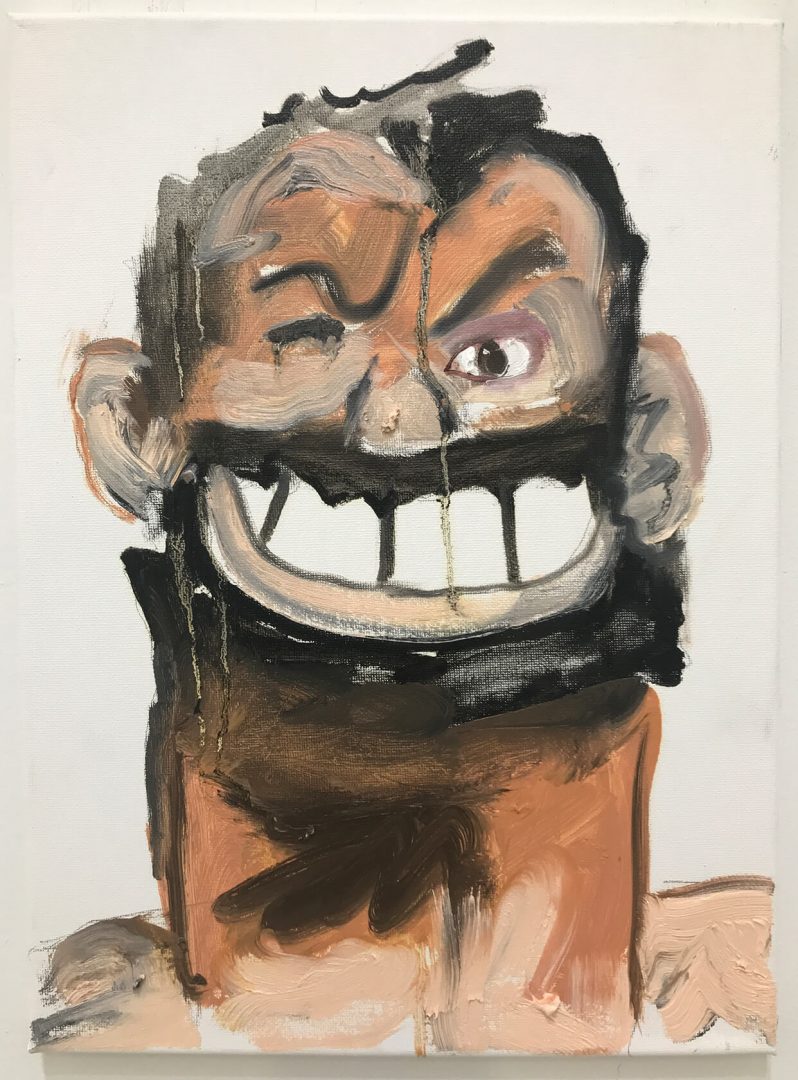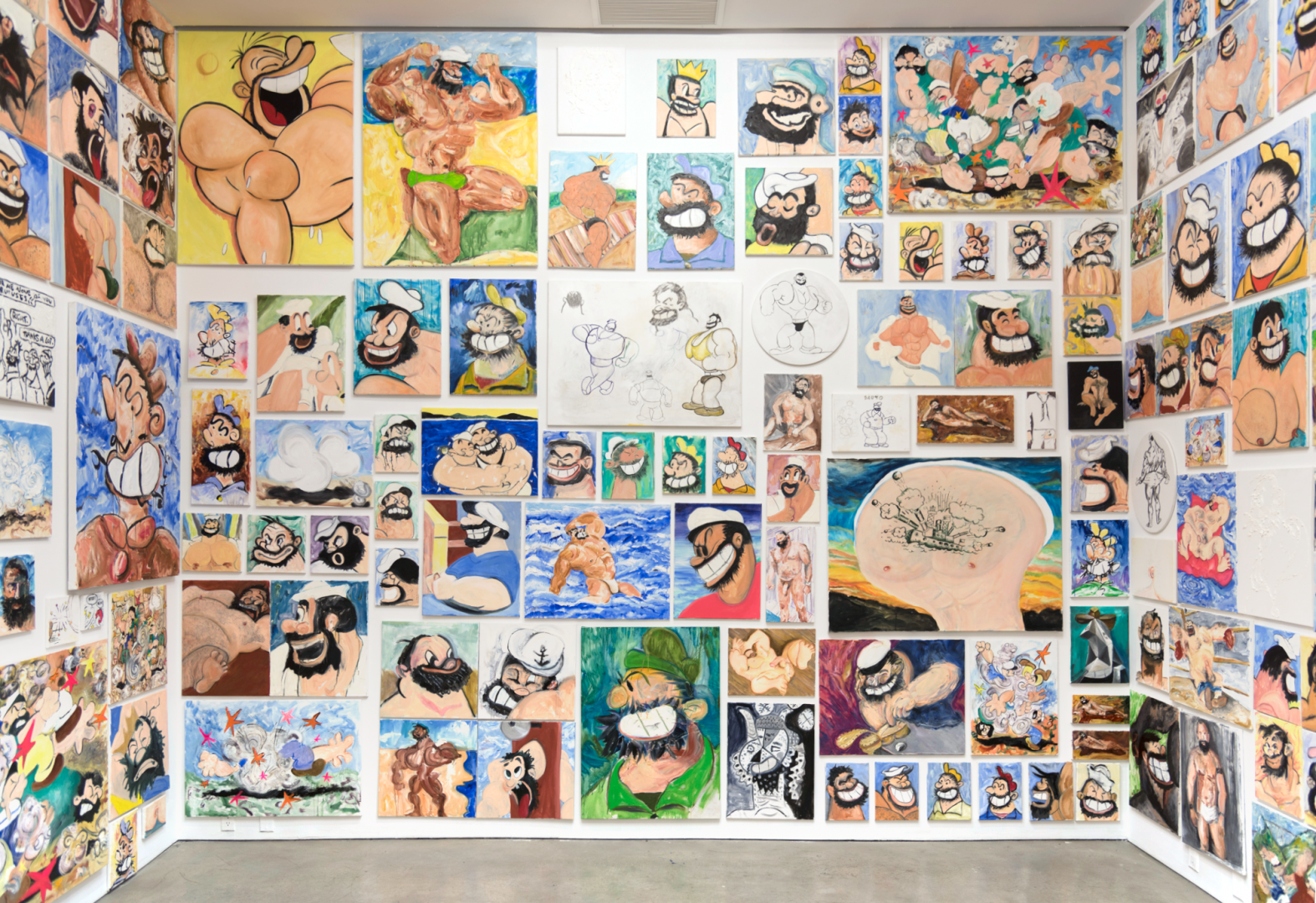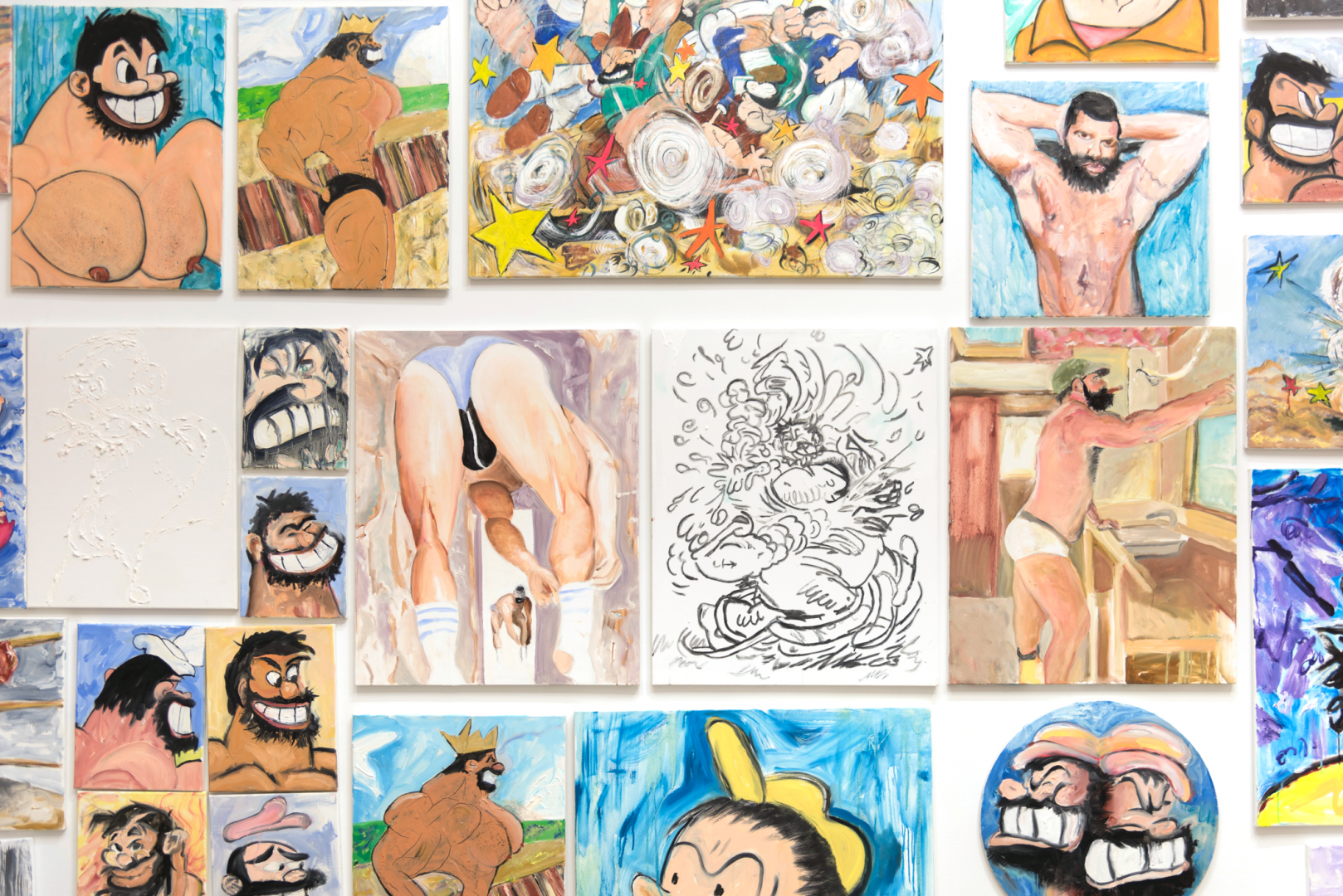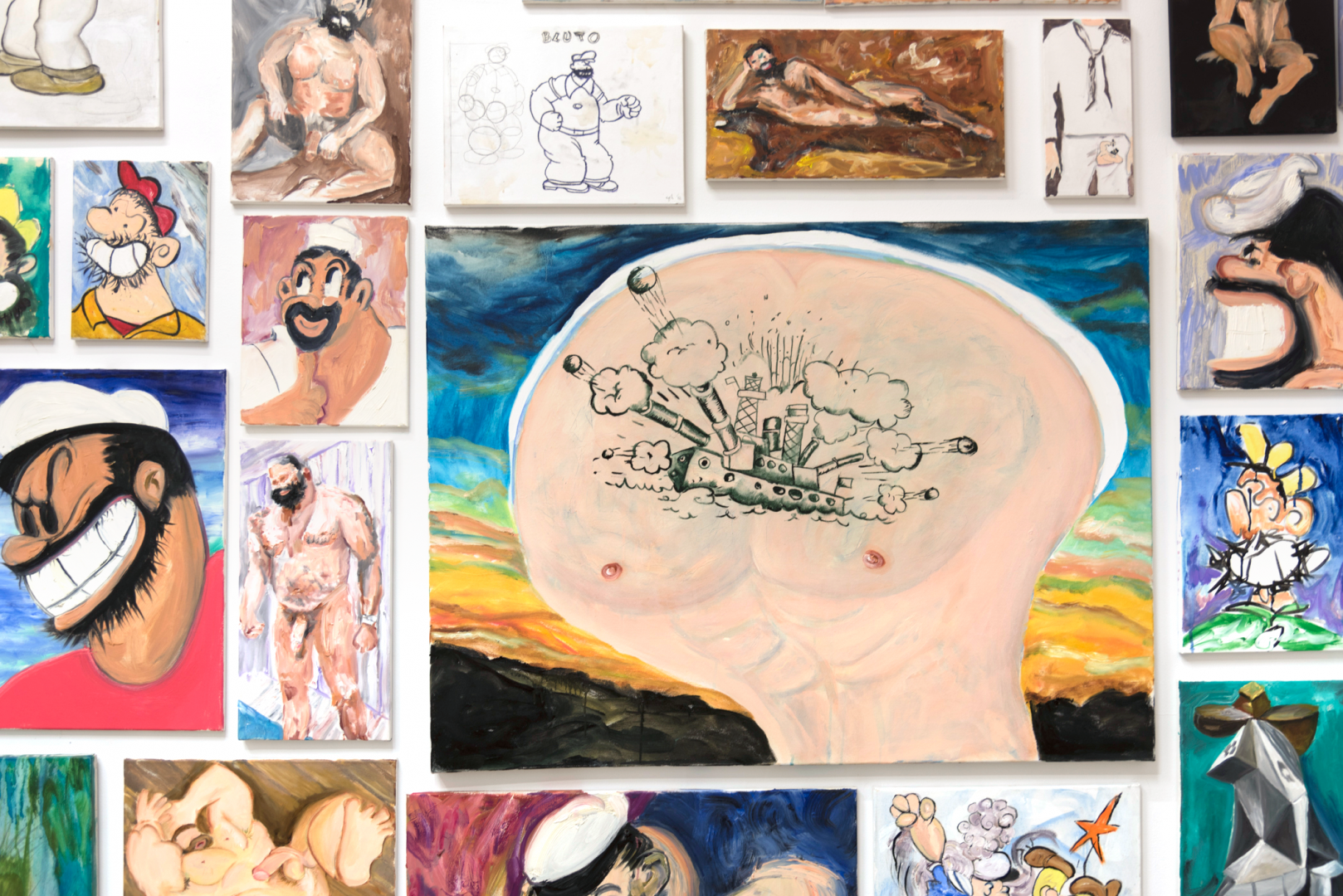Erik Hanson TWO YEARS OF BLUTO
Opening Reception:
February 23, 6 – 8 PM
New York
Here You Come Again: Repetition and Fidelity in Erik Hanson’s Bluto Paintings,
Ramzi Fawaz and David Getsy in Conversation
This conversation was held over email in December 2018.
David Getsy: We each went to see Erik Hanson’s paintings of Bluto installed in his studio on different occasions, and this exhibition seemed like a good opportunity to come together to pose some interdisciplinary questions about them. After all, we approach his work from different, though related, disciplines. Your work in comic studies and mine in art history both engage deeply with queer studies (among other things), and Hanson’s paintings stage exactly these kind of collisions. So, I’ll dive in and say that — whatever else they do — Hanson’s paintings immediately jumped out at me as a queer struggle with deep psychic attachments. They pore attention and affection on the villainized figure of Bluto, and it’s hard to decide when looking at the paintings (especially all together) where the love ends and where the misgivings start. The erotic pull of Bluto’s exaggerations is evident throughout even the most abstracting of Hanson’s paintings. Interwoven with this, however, is a critical and skeptical understanding of the limits of Bluto’s overplayed and phobically clichéd performance of masculinity. But isn’t that already part of Bluto’s role in the Popeye cartoons? For all the antagonism of Bluto, he is always needed by Popeye as the foil for the different version of masculinity that Popeye is understood to perform. What do we make of this preening bully?
Ramzi Fawaz: I think what is revealed in this series is that the the love and the misgiving we have toward Bluto’s “phobically clichéd performance of masculinity” are precisely the same thing. In these paintings, Hanson puts his finger on a sort of melancholic attachment that both gay men and the society at large have to the figure of hyper-masculinity — that ideal that both magnetizes our desire and constantly hurts us, reminding us we are never enough (never big enough, powerful enough, strong enough to be “real” men or desirable to those men who seemingly fit the ideal). We (both the particular subculture of gay men, but also a patriarchal culture as a whole) “love” men—some of us pursue them erotically, others symbolically or behaviorally worship at their imputed power—but that love is often exactly what undermines our own self-image, promotes rigid gender norms, and reproduces patriarchy. Part of the brilliance of these pieces, to my mind, is that they capture both what is so erotically appealing about Bluto—his baldly brutish masculinity—but also what is so tragic about his version of manliness, while never feeling sorry for, or making Bluto into a martyr. Bluto is wounded throughout the series, beaten up, given a black eye, made vulnerable to the erotic gaze, but he is not merely an icon of wounded masculinity. Rather his form of masculinity is painful, these images tell us. It wounds us all. And yet, we keep looking. We keep replaying that version of manliness in countless iterations. What exactly is the effect of this endless repetition, the variation on a theme, or ceaseless unfolding of Bluto into a seemingly indefinite future?
DG: Repetition is the key to these paintings, and it’s no surprise that when Hanson started showing them to people he aimed for a sort of visual overload. He installed them all clustered and stacked together as a means to reinforce and demonstrate his serial practice of grappling with this image. Hanson has talked about how the character of Bluto was both fascinating and fear-inducing, and it became a capacitating image for homoerotic investment and for anxieties about the queer transgression of normativity. Bluto was a conflicted model for his desire and adolescent relationship to gender. Returning to this stereotype in adulthood, Hanson has wrestled with its continued power even as he recognizes all that there is to criticize about it. Repetition is the form that this agonism has taken.
RF: I think this is beautifully captured in the earliest paintings in the series, the Warhol-esque portraits where Bluto is simply pictured head on, smiling at the viewer with a grin so wide it takes up a large portion of the image (the grin is always iconically painted as three huge teeth). Looking eerily similar to an annual class photo, this particular version of Bluto always seems to present him as innocent, playful, eager for approval and attention–he is that awkward or eccentric classmate we all had who had developed faster than most, growing a beard as an early teen, but still a kid playing Dungeons and Dragons. With some exceptions, this series within the series nearly always has Bluto wearing a collared shirt, indicating a sense of propriety: here, Bluto is presenting, and in his alert, smiling face, seeking our praise, like a little boy. As the series of images expands, this same figuration appears more and more often, but the grin becomes increasingly mischievous, maniacal, angry, and at times simply sexually suggestive in exciting and terrifying ways. Reversing the visual cues of the earliest images, these additions nearly always show Bluto with his shirt off, sometimes hairy chest on display, with his aggressive grin so wide that his eyes are usually closed. Two versions of masculinity then, unfolded across multiple overlapping sequences, one vulnerable, sweet and almost embarrassing in its desire for approval, the other menacing, yet attractive. Though it would be easy to read them as a simple progression from innocence to wildness, once on display in the open-ended spread that Hanson produces across a wall, the images melt into one another, producing a completely erratic sequences where the range of attributes flow in and out of one another seemingly without end. The mode of display reminds us that masculinity is shot through with vulnerability, violence, sweetness, aggression, eroticism, innocence, and that we may also be responsible for producing its many variations by the way we look at and attach ourselves to it.
DG: It’s really in the relentlessness of the series and subseries that these themes come into focus. Hanson’s work is obsessive — in the most replete sense of the word — in its constant return to that potent image, delicately re-worked each time. While there are the shifts in rendering and mood as we track the image across each successive painted version, there is a stubborn fidelity to the initial prototype. That is, within their subsets they continue to be recognizable as variations on a single image. Each painting is haunted by the previous retracings of that iconic profile. This repetitive re-drawing of the same contour is both a form of affection and a form of obligation. We might think of this as a kind of “muscle memory” (forgive the pun), in which each subsequent iteration of the Bluto image adds to Hanson’s facility with making that image and makes deeper his embodied knowledge of how to re-conjure it. This is not just a material and technical aspect of this serial practice. It is a bodily incorporation of that image achieved through repetition. But, more than that, this acquired intimacy is a manifestation of the dynamic contours of the psychic investment in that image. Hanson’s subordination of himself to the iconic image of Bluto, in other words, makes him the master of that image until — as with this exhibition — this image comes to stand for Hanson’s practice more broadly. That incorporative identification is both adoring and aggressive. It’s a working through of a gut attachment.
We also have to ask about what is kept and what is altered in the replications of that image across the subseries. The pull of the image of Bluto is riven with the question of the painter’s agency in remaking the same image. Where, in other words, does the fidelity to the ideal give way to the faithful’s recalcitrance to or fatigue with that ideal? None of these paintings can be seen monadically. The repetition (and the knowledge and fatigue that comes with it) leads to the accrual of acts of truculence, defiance, mischief, and play by the painter with that governing image.
RF: Here is where we see Hanson’s complex negotiation not only of masculinity, which has been our focus so far, but also of the comics medium from which a character like Bluto emerged: a mass cultural form, named after the “funnies” or early newspaper comic strips aimed at delivering short bursts of humorous narrative concluding with a punch-line. Late nineteenth and early twentieth century comics managed elaborate contradictions within early mass entertainment culture. They were highly repetitive; promulgated gendered, racial, and sexual stereotypes through the use and re-use of stock character types (in the case of Popeye, the strip in which Bluto famously came into pop cultural being, this included the figures of the heroic white working class sailor, the hyper-feminine damsel in distress love interest, and the nefarious dark-skinned muscle man); built narrative around common gags or jokes; and appeared serially each week in national newspapers. And yet, the serial quality of the comics, their unfolding across weeks, months, years, meant that regardless of how repetitive they were, they were also constantly open to revision, transformation, and expansion in future installments (which was also necessary to draw in new readers); each strip also entered the life world of any given reader in a distinct reading context, sometimes shared among family members or boarding house tenants, sometimes read in the privacy of one’s room, sometimes read on the street. In this way, a highly structured mass mediated form intersects with the infinite particularities of individual readers’ desires and fantasies, whether for a momentary good laugh or a lifetime of erotic attachment.
DG: That kind of temporally paced seriality becomes thematized in these paintings, and they nod to the ways that the unfolding of the lives of comics characters were coextensive with the lives of readers. But Hanson’s project also draws on the mode of seriality in the history of art. At times, the serial mode has been used to indicate a kind of research. (Think of Claude Monet’s riposte to Georges Seurat’s critique of his color theory. Monet’s grainstack paintings at different times of day were intended to demonstrate rigor.) Or, seriality became a way of pointing to systems and opposing the myth of the autonomous art object. (Dan Flavin’s positing of an infinite practice of recombinations of interchangeable fluorescent tubes or Donald Judd’s famous praise of seriality as being “simply order, like that of continuity, one thing after another.” — stances that Michael Fried notoriously criticized for valuing endlessness.) These examples are two of the most common in a long history of seriality, and I mention them both to signal that larger story and to indicate how Hanson’s work participates in it. But perhaps a better and more direct comparison might be not to Minimalist seriality but its Postminimalist adaptation. In particular, I’m thinking of the works of Eva Hesse which demonstrate how the serial mode can also be a way of thematizing personhood through playing out identicality and difference. Some of my favorite Hesse works are the most humble: a series of drawings on graph paper. Hesse would take a rectangular area in the middle of the page of graph paper and, in each square of the graph, draw a circle. It’s a simple practice, but it is profound in the ways in which one can discern the repeated struggle to conform to the given shape (and rules). Inescapable variation and difference happens in each iteration of that same thing. The viewer tracks the activity of Hesse’s attempts to make identical circles within the perfection of the printed grid, and this — for me at least — allegorizes the bigger issue of being both in-common and individual. They are all circles, bounded by perfect squares, and they’re all different, slightly. She worked out this question of difference-within-identicality in her sculptures, but these delicate little drawings are to me the key. I mention them here because of how they invest in seriality’s research, its call to system, and its endlessness not as cerebral tools but rather as emotionally-soaked practices of discovery through repetition. (Not to say that emotions — however cloaked — don’t run through the work of a Flavin, Judd, Fried, or Monet.) Hanson’s use of repetition and seriality is, like Hesse’s, not about equating all the iterations of a system but a working-through of staying-with a format, an image, and a form. This is where, I think, some of the accounts of seriality in art history connect up to the analysis of comics’ seriality and the temporally-extended and punctuated experience of reading them.
RF: Hanson’s obsessive repetition of Bluto, and the minute variations in his appearance, speaks to that very singular or particular experience of a reader—perhaps a young boy who will develop an erotic attachment to other boys, or a tomboy (or perhaps transgender girl) who identifies with a powerful male physique, or a wife who projects her husband, or a fantasized lover, onto Bluto, and on and on. Hanson’s expansion of the series into a range of iconic comics scenarios, including the explosive battle clouds where stars, fists, arms, and legs fly outward from a ball of dust indicating a fight sequence, the beach scenes in which Popeye and Bluto lay out on the sand, at times relaxing, at other times displaying their bodies, reminds us of the countless images and icons that comics offered readers to which they might attach their expanding fantasies. Comics, essentially, proliferate desiring possibilities in their potentially indefinite unfolding. No surprise perhaps that in his most recent additions to the series, Hanson make explicit reference to Joe Brainard’s brilliant Nancy series from the 1970s, in which Brainard produced a series of sexually and politically charged images of the iconic comic strip character Nancy that magnetize queer desires—the reference not only indicates Hanson’s affinity to that project, but his sense that, if a sequence continued to unfold, it would ultimately include within it not only iconic characters or scenarios but also the experiments of other artists, not to mention every form of desire imaginable. As the tragic muscle queen Malone famously states in Andrew Holleran’s 1978 gay literary classic Dancer from the Dance, “given enough time, everyone will sleep with everyone else”; and so too, given enough space, a sequence can account for, or represent, every desiring possibility.
DG: I see this all as closely related to Hanson’s earlier work, which took the stuff of adolescent and teenage identification — the song lyric — as its subject matter. We come to know our favorite songs “by heart,” to the point where we find we can sing along without thinking. That incorporation of the song as personal only happens through the repetitive replaying. The same approach to how repetition creates such deep identifications and meanings is being explored in a different direction in the Bluto paintings, which use repetition to gain distance and agency rather than to take the lyrics to heart. But with both, what is interesting is that a certain fatigue — or rather, an abundance of familiarity — causes us to move on to another song or a different image. However much that song’s lyrics are still imprinted in our memory and ready for recall, we find other songs that make us similarly feel absorbed. With the Bluto paintings, I’m really fascinated to see the ways in which Hanson has introduced elements like acts of aggression (the black eye that makes Bluto hotter in his vulnerability) and the expansion of the iconic image to other variations. He has started painting just parts of the iconography, or chosen other moments in which Bluto’s character is embroiled with others. (I particularly love the fight cloud subseries.) In some paintings, abstraction emerges as the founding image is lost or obscured, and I think the way that abstraction hovers around the later works in series, also, registers the emotional, gradual strain on fidelity that the repetition has caused.
RF: I think that ultimately, repetition is always inherently self destructive in the most productive way possible: it is, essentially the very promise that the next installment, the next go-around, the next attempt will be, quite simply, different. This is not an original insight but one that bears repeating (if you will). It is quite possible, that a series of Blutos that keeps unfolding will simply one day, not be a series of Blutos at all. That another detail, another character, another style or worldview or subtle shift in the artists’ tastes will occasion the unfolding of a different series, with different content or desiring positions. As the original “fidelity” to Bluto as figure both disperses and disintegrates into the diverse assemblage or array of Blutos that compose Hanson’s series, a shift in different kinds of representations gives way to a formal shift in Bluto’s very presentation so that he is in one iteration cubist, in another abstract, and in yet another minimalist according to Hanson’s aesthetic desire. Variation then seeps into every level of representation, but the reasons for such variation become as complex and dispersed as the original series itself: from the artists’ potential boredom, to their shifting interests or the influence of their interlocutors on the unfolding work. We cannot ultimately know what occasions the changes, nor should we pin the reason down. And by extension our own interests, our own fantasies and desires are revealed over and over not to be static or fixed, but perhaps totally transformable, so that maybe, just maybe, we can desire Bluto, and his ludicrous masculinity in one breath, in one panel, and in the next, forget we ever loved him at all.
Ramzi Fawaz is Associate Professor in the Department of English at the University of Wisconsin at Madison. He is the author of The New Mutants: Superheroes and the Radical Imagination of American Comics (NYU 2016) and co-edited the “Queer About Comics” special issue of American Literature (June 2018).
David J. Getsy is the Goldabelle McComb Finn Distinguished Professor of Art History at the School of the Art Institute of Chicago and author of, most recently, Abstract Bodies: Sixties Sculpture in the Expanded Field of Gender (Yale 2015) and editor of Queer for the Whitechapel Gallery’s “Documents of Contemporary Art” book series (MIT 2016).
-

Free Fallin', 5/2/18, oil on canvas, 16 x 12 in.
-

Installation View.
-

Installation View.
-

Installation View.